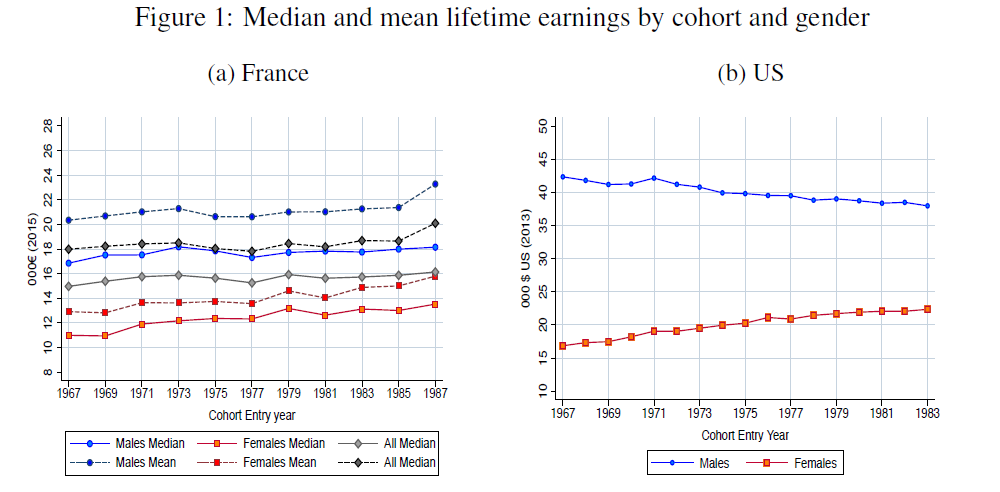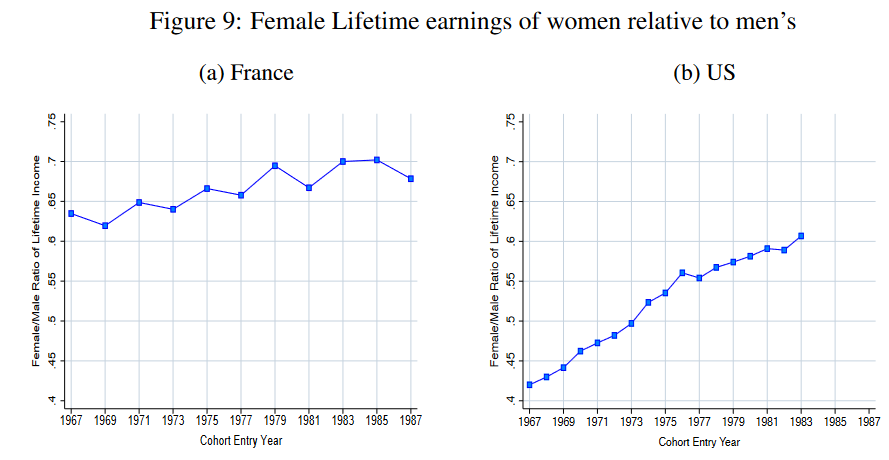How does inequality evolve over a lifetime? What are the differences in earnings between men and women over time?
Cross-sectional measures of earnings inequality have been widely used to assess the dynamics of inequality over time and for cross-country comparisons, but they have the limitation that individuals may change their position in the distribution. A broader perspective based on lifetime earnings – i.e. looking at an individual’s earnings over their entire life – can significantly enrich the analysis.
In this paper, Bertrand Garbinti, Cecilia García Peñalosa, Vladimir Pecheu and Frédérique Savignac provide estimates of lifetime earnings in France for a larger number of cohorts entering the labor market between 1967 and 1987. They analyze their determinants and the evolution of the gender gap in lifetime learnings and compare the results with those for the US.
Key findings
- Median lifetime earnings show similar flat trends in both countries, but in France this is due to a moderate increase for both men and women together with increased female participation, while in the US, lifetime earnings declined for men and rose for women.
 Panel (a) displays median and mean earnings for men, women, and the entire population (All) for France, and Panel (b) median lifetime earnings for the US. Data from the latter comes from Guvenen et al. 2022.
Panel (a) displays median and mean earnings for men, women, and the entire population (All) for France, and Panel (b) median lifetime earnings for the US. Data from the latter comes from Guvenen et al. 2022.
- The study identifies the main determinants of the dynamics of lifetime earnings in France:
- Education plays a key role in shaping lifetime earnings across cohorts. There was a decline in the returns to all educational qualifications other than master’s degrees (or above), accompanied by an increase in educational attainment.
- Working time (both regarding the number of years worked and the frequency of part-time employment) for men and women accounts for about 60% of the gender gap in lifetime earnings for the 1987 cohort, compared to only 30% for the 1967 cohort.
- Place of birth shapes lifetime earnings within a given cohort. For example, being born in the Paris region confers an advantage both because it leads to higher educational attainment and because those born in the Paris region (which pays the highest wages) tend to spend more years working here.
- In both the US and France, the gender gap in lifetime earnings has narrowed across cohorts. However, women’s lifetime earnings as a percentage of men’s are much higher in France, where this percentage increased from 64% to 68% (compared to about 42% to 61% in the US). In France, the contribution of working time to explaining the gender gap has increased from 30% to 60% across cohorts. This is because although younger women work more years than their predecessors, they have tended to increase their years in part-time employment, which has contributed to deepening the gender gap. At the same time, education has played a major role in reducing the gender gap, both through a rapid increase in female educational attainment and a reduction in the gap in the returns to education.
 The figures display the ratio between female and male lifetime earnings, for successive cohorts. Panel (a) reports results for France, and panel (b) for the US. Data from the latter graph comes from Guvenen et al. 2022
The figures display the ratio between female and male lifetime earnings, for successive cohorts. Panel (a) reports results for France, and panel (b) for the US. Data from the latter graph comes from Guvenen et al. 2022
AUTHORS
- Bertrand Garbinti, CREST-ENSAE-Institut Polytechnique Paris, CEPR, and WIL
- Cecilia García Peñalosa, Aix-Marseille University, CNRS, EHESS, Banque de France, CEPR and CESifo
- Vladimir Pecheu, Paris School of Economics, Institut des politiques publiques
- Frédérique Savignac, Banque de France
MEDIA CONTACT
- press[at]wid.world




